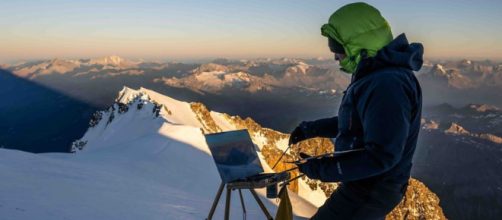Art for art’s sake, that old bromide left over from the 19th -century when artists rebelled against social realism, is losing ground. Now comes another rebellion: art as a sign of its time.
Global warming
When art and global warming come together in news reports, it’s usually about activists attacking famous artwork. Throwing, say, tomato soup at Van Gogh’s “Sunflowers” was an easy headline grabber.
But to raise awareness of climate change, British landscape painter James Hart Dykes put art to work. He found a way to demonstrate the trouble that planet earth faces in real time.
By retraced the steps of French artist Gabriel Loppe, who climbed the peaks of the Alps to paint them in 1863, Dykes painted the same peaks now as they disappear. As he told The Guardian: “I wanted to capture them again, partly to show the damage that’s already been done, and partly to share one more glimpse of Europe’s best-known mountain range before it disappears forever.”
'Forever' is almost here
What Dykes found when he reached the peaks 150 years after Loppe so upset him that he compared the view to the horrific “dark paintings” of Francisco Goya.
Remember those grim images of Goya’s disgust with humanity? One of these in particular could readily stand in for our ongoing abuse of the planet.
I’m thinking of Goya’s “Saturn Devouring His Son.” Even though the imagery follows the ancient Greek myth of Titan Cronus cannibalizing one of his children, it can also speak of our murderous ways with our planet.
Goya’s graphic description of a human figure eating a fellow human, complete with the head and part of an arm already swallowed, parallels our callousness toward Mother Earth.
Dykes said that when he climbed Mon Blanc, taking the same route used to reach the summit, he saw glaciers melting so rapidly that the surface was a mess to walk on: “The bottom of the glaciers have completely deteriorated: where Loppé saw pristine blue-white snow, I was looking at dirt and black ice.” And as he climbed, the rocks beneath him came loose.
There are many who protest climate change, including those who threw soup at “Sunflowers.” But Dykes thinks painting landscapes is the way to go.
And that goes double for picturing mountain scenery. According to Dykes, being on top of a mountain, “is the best place I can think of to celebrate life and to be aware of nature, and of the wonders of the planet.”
All of which explains why Dykes is big on wanting to see more landscape painting. “If we connect with it,” he said, “we’ll be more committed to the changes we have to make.”
And hey, if that doesn’t work, if this show doesn’t move the climate deniers, they ought to take a long look at Goya’s “Saturn Devouring His Son.”
Before and after
James Hart Dykes’ Alps paintings along with Gabriel Loppe’s pictures of the same scene debuts in the end of September at London’s Cromwell Place.


